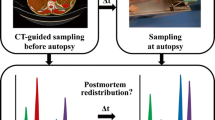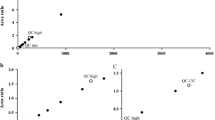Abstract
Interpretation of postmortem morphine concentrations in forensic toxicology provides several pitfalls such as missing information on tolerance, analyte stability, or postmortem redistribution (PMR). Recently, it had been shown that computed tomography (CT)-guided collection of biopsies using a robotic arm (virtobot) provides a valuable strategy for systematic studies on time-dependent PMR. Using this technique, time-dependent PMR of morphine and its metabolites was investigated in 12 cases. At admission to the institute (t1), femoral and heart blood (right ventricle) as well as biopsies from the right lung, the right kidney, liver, spleen, and muscle tissue were collected. At autopsy approximately 24 h later (t2), samples from the same body regions were collected again. Additionally, gastric contents, urine, brain tissue, and heart blood from the left ventricle was collected. Morphine, normorphine, hydromorphone, morphine-3-glucuronide, morphine-6-glucuronide, and morphine-sulfate were quantified with LC-MS/MS. In femoral blood, significant increase of morphine concentrations was observed, although ultimately not relevant for forensic interpretation. In the alternative matrices, increases as well as decreases were observed without a clear trend. The morphine metabolites did not exhibit relevant concentration changes. Investigation of underlying redistribution mechanisms indicated that concentration change (i.e., increase) of morphine in femoral blood rather resulted from diffusion processes than from release of morphine from its conjugates. Concentration changes in heart blood might have been caused by redistribution from lung tissue or gastric content. This study also proved that CT-guided collection of biopsies using a virtobot arm is an invaluable tool for future studies on PMR redistribution of other substance groups.






Similar content being viewed by others
References
Moriya F, Hashimoto Y (1997) Distribution of free and conjugated morphine in body fluids and tissues in a fatal heroin overdose: is conjugated morphine stable in postmortem specimens? J Forensic Sci 42(4):736–740
Pelissier-Alicot AL, Gaulier JM, Champsaur P, Marquet P (2003) Mechanisms underlying postmortem redistribution of drugs: a review. J Anal Toxicol 27(8):533–544
Carroll FT, Marraccini JV, Lewis S, Wright W (2000) Morphine-3-D glucuronide stability in postmortem specimens exposed to bacterial enzymatic hydrolysis. Am J Forensic Med Pathol 21(4):323–329
Skopp G, Potsch L, Klingmann A, Mattern R (2001) Stability of morphine, morphine-3-glucuronide, and morphine-6-glucuronide in fresh blood and plasma and postmortem blood samples. J Anal Toxicol 25(1):2–7
Skopp G, Lutz R, Potsch L, Ganssmann B, Klinder K, Schmidt A, Aderjan R, Mattern R (1997) An in vitro experiment for postmortem vascular permeation. The passage of morphine and morphine glucuronides across a vascular wall. J Forensic Sci 42(3):486–491
Skopp G, Lutz R, Ganssmann B, Mattern R, Aderjan R (1996) Postmortem distribution pattern of morphine and morphine glucuronides in heroin overdose. Int J Legal Med 109(3):118–124
Sawyer WR, Forney RB (1988) Postmortem disposition of morphine in rats. Forensic Sci Int 38(3–4):259–273
Koren G, Klein J (1992) Postmortem redistribution of morphine in rats. Ther Drug Monit 14(6):461–463
Crandall CS, Kerrigan S, Aguero RL, Lavalley J, McKinney PE (2006) The influence of collection site and methods on postmortem morphine concentrations in a porcine model. J Anal Toxicol 30(9):651–658
Maskell PD, Albeishy M, De Paoli G, Wilson NE, Seetohul LN (2015) Postmortem redistribution of the heroin metabolites morphine and morphine-3-glucuronide in rabbits over 24 h. Int J Legal Med 130(2):519–531
Hargrove VM, Molina DK (2014) Peripheral postmortem redistribution of morphine. Am J Forensic Med Pathol 35(2):106–108
Gerostamoulos J, Drummer OH (2000) Postmortem redistribution of morphine and its metabolites. J Forensic Sci 45(4):843–845
Gerostamoulos D, Beyer J, Staikos V, Tayler P, Woodford N, Drummer OH (2012) The effect of the postmortem interval on the redistribution of drugs: a comparison of mortuary admission and autopsy blood specimens. Forensic Sci Med Pathol 8(4):373–379
Logan BK, Smirnow D (1996) Postmortem distribution and redistribution of morphine in man. J Forensic Sci 41(2):221–229
Tolliver SS, Hearn WL, Furton KG (2010) Evaluating the relationship between postmortem and antemortem morphine and codeine concentrations in whole blood. J Anal Toxicol 34(8):491–497
Staeheli SN, Gascho D, Fornaro J, Laberke P, Ebert LC, Martinez RM, Thali MJ, Kraemer T, Steuer AE (2016) Development of CT-guided biopsy sampling for time-dependent postmortem redistribution investigations in blood and alternative matrices-proof of concept and application on two cases. Anal Bioanal Chem 408(4):1249–1258
Ebert LC, Ptacek W, Breitbeck R, Furst M, Kronreif G, Martinez RM, Thali M, Flach PM (2014) Virtobot 2.0: the future of automated surface documentation and CT-guided needle placement in forensic medicine. Forensic Sci Med Pathol 10(2):179–186
Staeheli SN, Poetzsch M, Kraemer T, Steuer AE (2015) Development and validation of a dynamic range-extended LC-MS/MS multi-analyte method for 11 different postmortem matrices for redistribution studies applying solvent calibration and additional (13)C isotope monitoring. Anal Bioanal Chem 407(29):8681–8712
Taylor K, Elliott S (2009) A validated hybrid quadrupole linear ion-trap LC-MS method for the analysis of morphine and morphine glucuronides applied to opiate deaths. Forensic Sci Int 187(1–3):34–41
Andersson M, Bjorkhem-Bergman L, Ekstrom L, Bergqvist L, Lagercrantz H, Rane A, Beck O (2014) Detection of morphine-3-sulfate and morphine-6-sulfate in human urine and plasma, and formation in liver cytosol. Pharmacol Res Perspect 2(6):e00071
Wyman J, Bultman S (2004) Postmortem distribution of heroin metabolites in femoral blood, liver, cerebrospinal fluid, and vitreous humor. J Anal Toxicol 28(4):260–263
Baselt RC (2008) Disposition of toxic drugs and chemicals in man, 8th edn. Chemical Toxicology Institute, Foster City
Pounder DJ, Smith DR (1995) Postmortem diffusion of alcohol from the stomach. Am J Forensic Med Pathol 16(2):89–96
Han E, Kim E, Hong H, Jeong S, Kim J, In S, Chung H, Lee S (2012) Evaluation of postmortem redistribution phenomena for commonly encountered drugs. Forensic Sci Int 219(1–3):265–271
Carrupt PA, Testa B, Bechalany A, el Tayar N, Descas P, Perrissoud D (1991) Morphine 6-glucuronide and morphine 3-glucuronide as molecular chameleons with unexpected lipophilicity. J Med Chem 34(4):1272–1275
Acknowledgments
This work was supported by the Swiss National Science Foundation (grant no. 310030_165875). The authors would like to thank the group from the Department of Forensic Medicine and Imaging, ZIFM, for their assistance and Prof. B. Seifert and the scientists from the Department of Forensic Pharmacology and Toxicology, ZIFM, for helpful discussions.
Author information
Authors and Affiliations
Corresponding author
Ethics declarations
Declaration of no objection for ethical approval was obtained by the cantonal ethics committee of Zurich, Switzerland (number 42.2005).
Conflict of interest
The authors declare that they have no conflict of interest.
Rights and permissions
About this article
Cite this article
Staeheli, S.N., Gascho, D., Ebert, L.C. et al. Time-dependent postmortem redistribution of morphine and its metabolites in blood and alternative matrices—application of CT-guided biopsy sampling. Int J Legal Med 131, 379–389 (2017). https://doi.org/10.1007/s00414-016-1485-2
Received:
Accepted:
Published:
Issue Date:
DOI: https://doi.org/10.1007/s00414-016-1485-2




